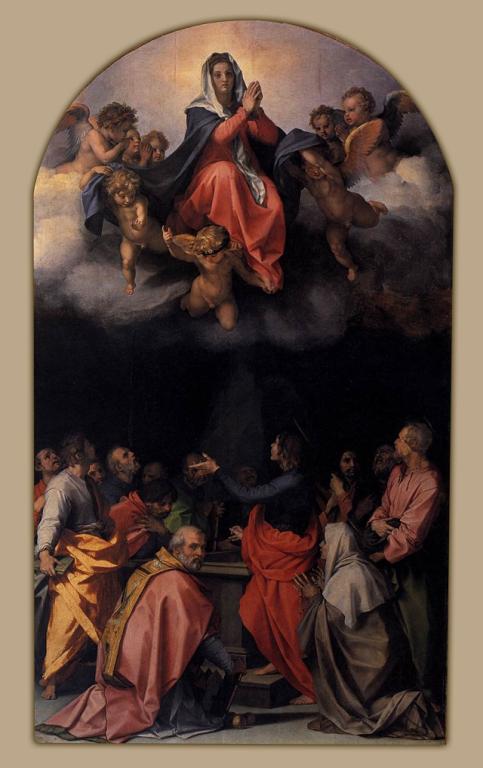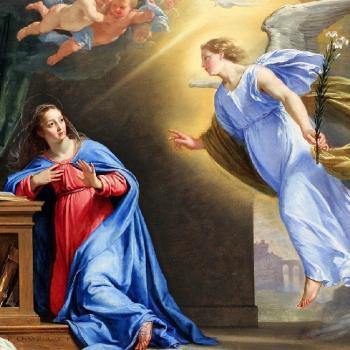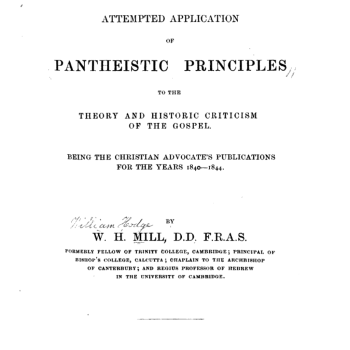
Assumption of the Virgin (1526-1529), by Andrea del Sarto (1486-1530) [public domain / Wikimedia Commons]
***
(6-30-08)
***
I’ve documented in the past that both Catholic and Protestant (including Lutheran) historians and Luther scholars accept the fact that Luther believed in the Assumption, at least in his early days, if not later. Catholic writer Thomas A. O’Meara, O. P., presents the confusing evidence about Luther (claiming he did accept this doctrine early on):
In 1522 Luther preaches on the feast of the Assumption, apparently taking this belief for granted, although he notes that it is not an article of faith . . . [WA, 10, III, 268]. In 1530 he decrees that the Assumption is an aspect of the “hypocritical Church” which should be eliminated. [WA, 30, II, 351]. In 1544 the Assumption is abandoned as a feast . . . [WA 52, 681] The period of drastic change lies within the years 1522 to 1532. It is impossible to pinpoint the moment of change, for as is usual in Luther the change is gradual and there are inconsistencies and reversals. In 1521 Luther says he does not know exactly when he gave up the veneration of the saints and of Mary, but in 1526 he writes that he venerated the saints for thirty years. (Mary in Protestant and Catholic Theology, New York: Sheed & Ward, 1966, 118-119; my bolded emphases, as throughout)
Lutheran scholar Eric W. Gritsch, who was a major translator in the English set of the works of Luther (edited by Jaroslav Pelikan), also states pretty much the same, from the same evidence (the 1522 sermon):
Luther affirmed Mary’s assumption into heaven but did not consider it to be of benefit to others or accomplished in any special way. (in The One Mediator, the Saints, and Mary, Lutherans and Catholics in Dialogue VIII, edited by H. George Anderson, J. Francis Stafford, Joseph A. Burgess, Minneapolis: Augsburg Fortress Press, 1992, 241; footnote 44; p. 382: “Sermon on the Festival of the Assumption, August 15, 1522. WA 10/3:269.12-13. Sermon on the Festival of the Visitation . . . August 15, 1522. WA 52:681.27-31.”; my emphasis)
In the same book, twelve Lutheran and ten Catholic scholars participated. Their “Common Statement” (a sort of creed-like formulation agreed-upon by all) yielded some very interesting conclusions indeed:
(89) Luther preached on the Assumption . . . There were early Lutheran pastors who affirmed the Assumption as both evangelical and Lutheran.
(101) From the Lutheran side, one may recall the honor and devotion paid to the Mother of God by Luther himself, including his own attitude to the Immaculate Conception and the Assumption, which he accepted in some form. (p. 55)
Luther signed an August 19, 1527 letter to Georg Spalatin in the following (very “unProtestant”) manner:
Yours, Monday after the Assumption of Mary, 1527. Martin Luther. (in Luther: Letters of Spiritual Counsel, edited and translated by Theodore G. Tappert, Vancouver: Regent College Publishing, 2003, 230)
Historic Lutheranism has also, in various places, retained the Feast of the Assumption on the liturgical calendar. For example, the Wikipedia article, “Liturgical calendar (Lutheran)” notes:
Some of the Marian festivals, notably the Nativity of Mary (September 8) and her Assumption (August 15) were retained by Luther whereas the feasts of her conception and presentation in the Temple were suppressed “because they were judged to have no scriptural or dogmatic interest.”
[source: Frank C. Senn, Christian Worship and Its Cultural Setting, 344]
The Swedish Mass draws from a number of different sources, though Luther’s Formulae Missae is apparent in regards to the Eucharistic structure [1] This included revising the calendar along similar lines as those in Germany. Laurentius Petri further revised the Swedish Mass 1557. In large part, the Swedish liturgy retained “vestments, altars and frontals, gold and silver chalices and patens” and many other “popish” customs. [2] Following Laurentius’ death in 1573, King John III embarked on a separate, though similar, religious policy more conciliatory towards Catholicism. Much of his work was in the area of liturgy and his Nova Ordinantia reinstated much of the sanctoral cycle from the Old Swedish Mass, reviving the feasts of Saint Mary Magdalene, Saint Lawrence, Corpus Christi, and the Assumption and Nativity of Mary. [3]
[footnotes: (1) Senn, 407; (2) Senn, 415; (3) Senn, 419; my emphases for both paragraphs]
Lutheran Latif Haki Gaba, who oversees “a Traditionalist Lutheran Blog,” writes about this feast day in Lutheranism:
The LCMS Lutheran could call it the feast of Mary’s Assumption. Most Lutherans, even of those dissatisfied with the Missouri Synod’s practice, shy away from this, for a variety of reasons. Not all have all the same reasons. You would really need to ask each Lutheran who dislikes using “Assumption” just why it is that he feels that way. Some say, for example, that it is Roman Catholic. Lutherans are not Catholic. Therefore it is unLutheran terminology. This logic has many problems, but for now let us just point out that Mary’s Assumption is not something that has ever been condemned by the Lutheran Church. In fact, there is a history of this feast being kept as the Assumption in the Reformation churches. As Professor Joseph Herl shows in his book, Worship Wars in Early Lutheranism, [p. 254] the Assumption is listed in the church orders in Weissenburg 1528, Dessau 1532, Nordlingen 1538, Brandenburg 1540, Palatinate-Neuburg 1543, Schwabisch Hall 1543, Brandenburg-Ansbach-Kulmbach 1548, Hohenlohe 1553, & Nuremberg 1543. To dogmatize the Assumption, as Rome did in 1950, is not the sort of thing the Church of the Augsburg Confession would do, yet it is quite another thing to claim that the Assumption itself (the event, not the dogma) is impossible and unLutheran.
There is another option, namely, to see this as the feast of Mary’s Dormition. Some see this as too Byzantine, too Orthodox. Here we must clarify a few things. One is that there is no conflict or contradiction between the Assumption and the Dormition, as if one necessarily cancels the other out. Many of those who, even in the ancient church, believed and celebrated and preached the Dormition also believed that Mary was taken bodily to heaven. Likewise many who believe in Mary’s assumption also believe that she did in fact die. Even the Roman Church’s official definition of the dogma of the Assumption allows for Mary’s death at the end of her earthly life, contrary to what I’ve heard some claim about that dogma. Many do prefer to simply celebrate this, though, as Mary’s Dormition, and to be content that she is now in heaven.
Trent Sebits, of unknown denominational affiliation (but presumably Lutheran), wrote in a combox on the popular blog of Lutheran pastor Paul T. McCain (on 16 August 2007):
I have a Lutheran liturgical calendar from 1879, published out of Pennsylvania, that lists Aug. 15th as, “Assumption of the BVM”. Interesting to note that not only did the Lutheran publishers of this calendar call it the assumption, buy also refer to St. Mary as still a virgin at the time of her assumption . . . two pretty unpopular stances in Lutheranism these days.
As to other Protestant “Reformers,” there is evidence that some accepted this doctrine or something quite similar to it:
In regard to the Marian doctrine of the Reformers, we have already seen how unanimous they are in all that concerns Mary’s holiness and perpetual virginity. Whatever the theological position which we may hold today, in regard to the Immaculate Conception and Assumption of Mary it is right to know, perhaps to our great surprise, that these two Catholic dogmas were accepted by certain Reformers, not of course in their present form but certainly in the form that was current in their day.
(Reformed scholar Max Thurian, Mary: Mother of all Christians, translated by Neville B. Cryer, New York: Herder & Herder, 1963, 197)
Noted Protestant scholar Donald G. Bloesch concurs:
It is well to note that the notions of Mary’s immaculate conception, her assumption, her perpetual virginity and her spiritual motherhood were all present in varying degrees among the Protestant Reformers. Zwingli could refer to Mary as “the Mother of God, the perpetually pure and immaculate Virgin Mary.” The Reformed theologian Henry Bullinger seemed to support the assumption of Mary when he declared that “the most pure chamber of the Mother of God and the temple of the Holy Spirit, her most holy body, was taken up by the angels to heaven.” (Jesus Christ: Savior & Lord, Downers Grove, Illinois: InterVarsity Press, 1997, 116-117)
In another book, Bloesch wrote:
[T]he Reformers did not jettison all Marian doctrine . . . Bullinger, Zwingli’s successor, held that Mary was taken up bodily into heaven. (The Church: Sacraments, Worship, Ministry, Mission, Downers Grove, Illinois: InterVarsity Press, 2002, 67)
Fr. Dwight Longenecker, in a debate book about Mary with Episcopalian David Gustafson, noted how many Anglicans have accepted Mary’s Assumption in faith:
[I]t was held by Lutherans at the Reformation and by many Lutherans today. It is also affirmed by the Anglican Church. The Scottish Anglican lectionary actually celebrates a feast of the Falling Asleep of Mary on the fifteenth of August just as the Orthodox and Catholics do. The new lectionary in the Church of England also institutes a Marian feast on the fifteenth of August in keeping with the tradition. Even your own Episcopal Church of the USA celebrates a Marian feast on the traditional date for the Feast of the Assumption. On that day Episcopalians pray, “O God, you have taken to yourself the Blessed Virgin Mary, . . . grant that we may share with her the glory of your eternal kingdom.” . . . If you allow for the Assumption as a permissible pious opinion, you’ve left the door open, and that isn’t really “heretical denial.” (Mary: A Catholic-Evangelical Debate, Gracewing Publishing, 2003, 128-129)
The most remarkable assertion of Mary’s Assumption or something highly akin to it, by a major Protestant “Reformer” that I’ve found, was made by Heinrich Bullinger of Zurich (alluded to above):
Elijah was transported body and soul in a chariot of fire; he was not buried in any Church bearing his name, but mounted up to heaven, so that . . . we might know what immortality and recompense God prepares for his faithful prophets and for his most outstanding and incomparable creatures. . . . It is for this reason, we believe, that the pure and immaculate embodiment of the Mother of God, the Virgin Mary, the Temple of the Holy Spirit, that is to say her saintly body, was carried up to heaven by the angels.
(in Thurian, ibid., 197-198; for further secondary and primary source information, see my paper specifically devoted to that issue; the quotation comes from a 1568 work entitled De Origine Erroris)
*****
Meta Description: There is a surprising amount of acceptance & celebration of Mary’s Assumption in Protestant history: especially in Lutheranism.
Meta Keywords: Assumption, Mary’s Assumption, Bodily Assumption of Mary, Assumption of Mary, Glorious Assumption, Bullinger & the Assumption, Bullinger’s mariology, general resurrection, Heinrich Bullinger, Immaculate Conception, Mariology, Mary, Protestant Mariology, Protestants & the Assumption, Dormition, Lutherans & the Assumption, Lutheran Mariology













